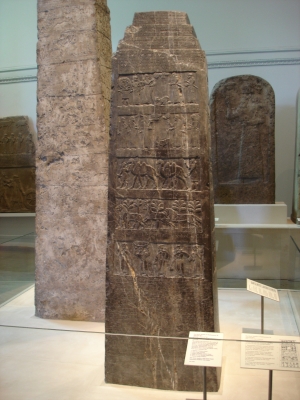Black Obelisk of Shalmaneser III: Difference between revisions
Enthusiast01 (talk | contribs) |
Enthusiast01 (talk | contribs) |
||
| Line 20: | Line 20: | ||
<blockquote>''“The tribute of [[Jehu]], son of [[Omri]]: I received from him silver, gold, a golden bowl, a golden vase with pointed bottom, golden tumblers, golden buckets, tin, a staff for a king [and] spears."''</blockquote> |
<blockquote>''“The tribute of [[Jehu]], son of [[Omri]]: I received from him silver, gold, a golden bowl, a golden vase with pointed bottom, golden tumblers, golden buckets, tin, a staff for a king [and] spears."''</blockquote> |
||
In the Obelisk, Jehu's name appears as ''<sup>m</sup>Ia-ú-a mar <sup>m</sup>Hu-um-ri-i'' or "Jehu son of Omri (Bit-Khumri"). The House of Omri was an Assyrian name for the Kingdom of Israel. |
|||
==See also== |
==See also== |
||
Revision as of 23:23, 27 March 2010
- For the band see: Black Obelisk (band)

The "Black Obelisk of Shalmaneser III" is a black limestone Neo-Assyrian bas-relief sculpture from Nimrud (ancient Kalhu), in northern Iraq, commemorating the deeds of King Shalmaneser III (reigned 858-824 BC). It is the most complete Assyrian obelisk yet discovered, and is historically significant because it displays the earliest ancient depiction of an Israelite. Tribute offerings are shown being brought from identifiable regions and peoples. It was erected as a public monument in 825 BCE at a time of civil war. It was discovered by archaeologist Sir Austen Henry Layard in 1846 and is now in the British Museum. A replica can be found at the Oriental Institute in Chicago, Illinois.
Description
Height: 197.85 cm-(~6.5 ft). Width: 45.08 cm-(~1.5 ft).
The obelisk features twenty reliefs, five on each side. They depict five different subdued kings, bringing tribute and prostrating before the Assyrian king. From top to bottom they are: (1) Sua of Gilzanu (in north-west Iran), (2) "Jehu of Bit Omri" (Jehu of the House of Omri), (3) an unnamed ruler of Musri (probably Egypt), (4) Marduk-apil-usur of Suhi (middle Euphrates, Syria and Iraq), and (5) Qalparunda of Patin (Antakya region of Turkey). Each scene occupies four panels around the monument and is described by a cuneiform script above them.
On the top and the bottom of the reliefs there is a long cuneiform inscription recording the annals of Shalmaneser III. It lists the military campaigns which the king and his commander-in-chief headed every year, until the thirty-first year of reign. Some features might suggest that the work had been commissioned by the commander-in-chief, Dayyan-Assur.
Israelite scene

The second register from the top includes the earliest surviving picture of an Israelite: the Biblical Jehu, king of Israel. It describes how Jehu brought or sent his tribute in or around 841 BCE.[1]
Jehu severed Israel’s alliances with Phoenicia and Judah, and became subject to Assyria. The caption above the scene, written in Assyrian cuneiform, can be translated:
“The tribute of Jehu, son of Omri: I received from him silver, gold, a golden bowl, a golden vase with pointed bottom, golden tumblers, golden buckets, tin, a staff for a king [and] spears."
In the Obelisk, Jehu's name appears as mIa-ú-a mar mHu-um-ri-i or "Jehu son of Omri (Bit-Khumri"). The House of Omri was an Assyrian name for the Kingdom of Israel.
See also
References
- ^ Millard, Alan (1997) Discoveries from Bible Times, Oxford, Lion, p121
External links
- British Museum page on the Black Obelisk
- The finding of the Black Obelisk (has a nice closeup of one of the panels)
- Photo; Article
- Photo; Article
- Jehu Panel; Article
